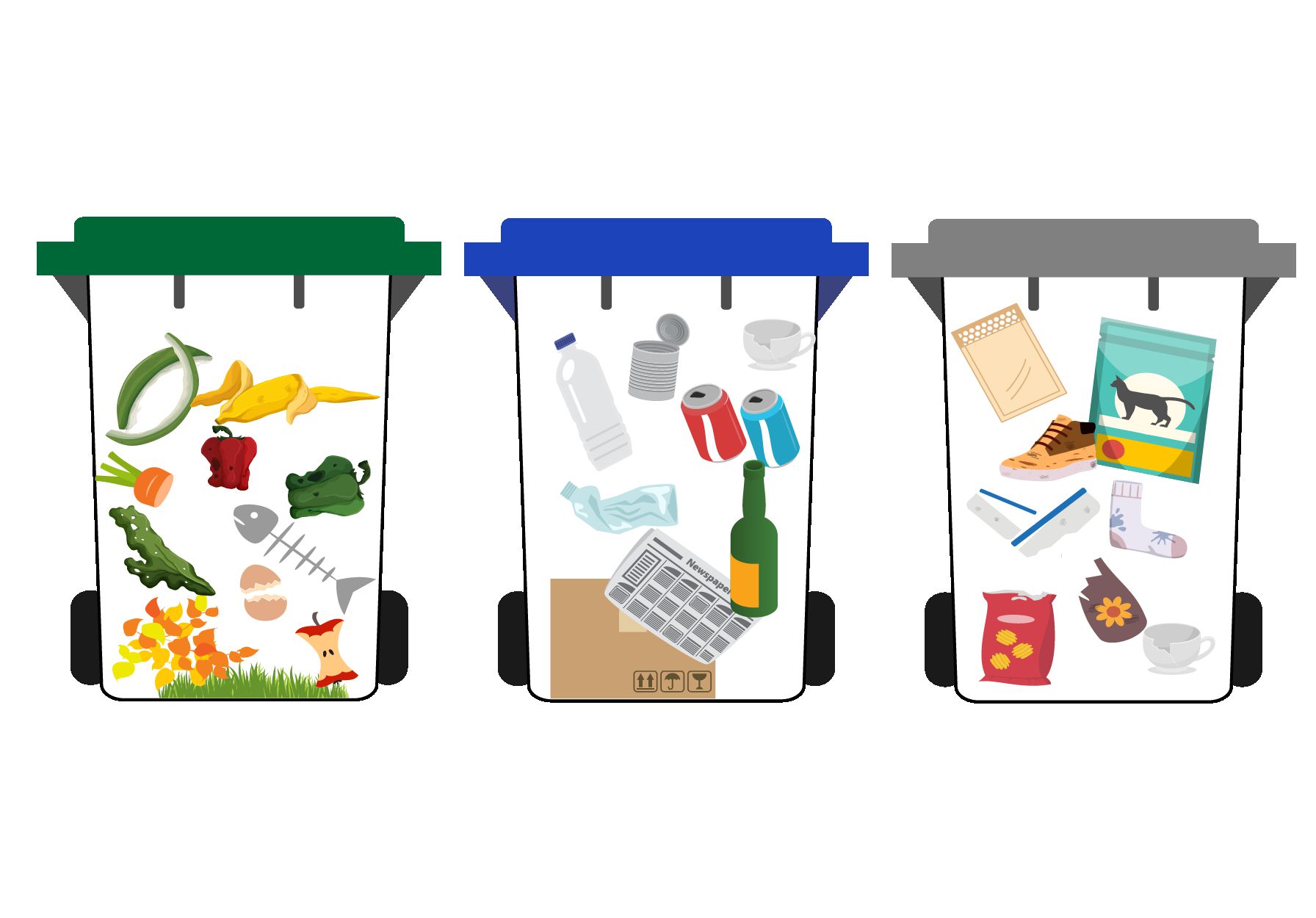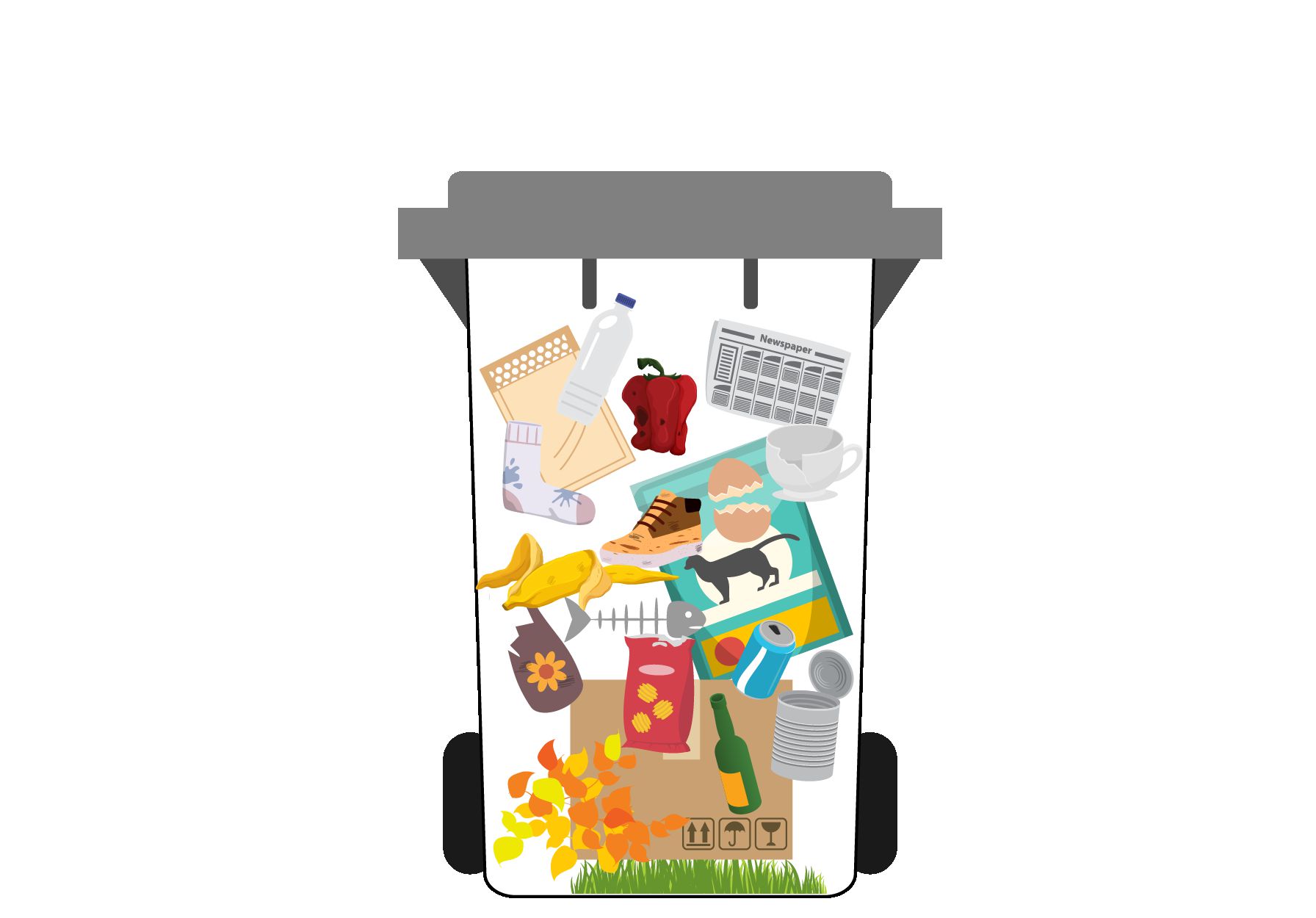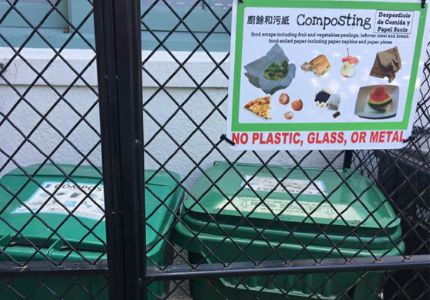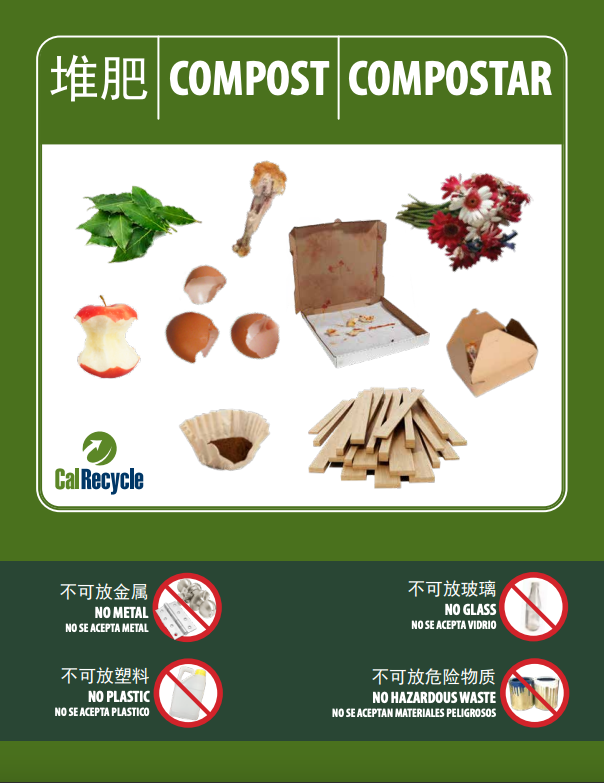Collection Systems, Container Colors, and Labeling
Clean streams of organic material must be collected, recovered, and recycled into new end-products like compost or biofuel.
To create high-quality recycled organics products:
- Residents and businesses must sort materials correctly.
- Jurisdictions must monitor containers for contamination.
The law allows jurisdictions to have 3, 2, or 1-container collection systems to work with local waste processing facility infrastructure.
The law requires jurisdictions to provide both:
- Standard colors for residential and business curbside containers and
- Container labels on new containers.
Collection Service Options
The law allows jurisdictions to provide:
- Residents and businesses to separate material into 3, 2, or more containers OR
- Single-container waste collection with organic waste collected in a container with garbage and recyclables, and then separated at a high-diversion organic waste processing facility.
The law allows jurisdictions to provide one or more of the following collection services:
- 3 or 3+ container system that requires the material to be properly separated
- 2-container system that requires the material to be properly separated, then further separates containers with mixed material types at a high-diversion organic waste processing facility
- Single-container system in which materials are separated at a high-diversion organic waste processing facility
If certain conditions are met, jurisdictions may also allow:
- Uncontainerized green and yard waste collection, like landscaping waste in the street
- Plastic bags and/or compostable plastics in green containers at the jurisdiction’s discretion
Jurisdictions may have one or more types of collection services in their community.
For example, a jurisdiction may provide:
- 2-container collection service to businesses and
- 3-container collection service to single-family residences.
Residents and businesses must properly sort their organic waste based on the service provided.
Examples of Container Collection Services
Check with your local jurisdiction to ensure proper sorting of materials.
3-Container Collection Service
In a 3-container system, residents and businesses must separate organic waste, traditional recyclables, and items going to a landfill.
- Green Container: Only includes food waste, yard waste, green waste, and other organic materials.
- Blue Container: Only contains traditional recyclables, like bottles, cans, and plastic, and some organic waste, such as clean paper and cardboard.
- Gray Container: Only contains waste that is not organic or recyclable.
- If a jurisdiction allows organic waste in the gray container, then the contents must be separated at a high-diversion organic waste processing facility.
- If a jurisdiction does not allow organic waste in the gray container, then the contents do not have to go to a high diversion organic waste processing facility.
2-Container Collection Service
In a 2-container system, residents and businesses separate materials into two bins that are either:
- Blue and gray or
- Green and gray.
Jurisdictions and haulers determine which materials to collect in each container.
In a 2-container system, a gray container must go to a high-diversion organic waste processing facility.
Organics like paper and cardboard collected in the:
- Blue Container: Should be dry and free of debris to get recycled into new paper and cardboard products.
- Green Container: Do not need to be dry when collected with yard and food waste because all of organics get composted together.

Option A: Gray and Green Containers
- Gray Container: Allows organic waste, like paper, cardboard, and non-organic recyclables, like bottles and cans, and trash.
- Green Container: Limited to only organics, like food and yard waste, sent to a source separated organics facility.

Option B: Gray and Blue Containers
- Gray Container: Allows organics, such as food and yard waste, and trash.
- Blue Container: Limited to traditional recyclables, like bottles, and cans, and some organics, such as paper and cardboard.
Single Container Collection Service

In a single-container collection service, residents and businesses put all materials in a single gray container.
Haulers collect and then deliver the material to a high-diversion organic waste processing facility that separates materials into multiple streams, including recyclables, organics, and items going to a landfill.
High-Diversion Organic Waste Processing Facilities
Jurisdictions collecting organic waste in the same container as recyclables and/or landfill items must send the mixed waste to a high-diversion organic waste processing facility to recover the organics and recyclables for both:
- The single-container collection and
- The gray bin in a 2- or 3-container collection.
High-diversion organic waste processing facilities must demonstrate they:
- Can separate and recover 75% of organic materials in the mixed waste stream.
- Have little contamination (under the incompatible materials limit) in organic materials that are sent for further processing.
- Recovered organic material over the incompatible materials limit must go to another facility that will further process that waste.
Performance-Based Source Separated Organics Collection Service
Fewer Collection Requirements with Lower Organics Contamination
Jurisdictions with high-performing organics collection programs yielding a clean organics stream may not need to implement every requirement to comply. The jurisdiction may choose to implement a performance-based source-separated organics collection service.
Jurisdiction with performance-based source separate organics collection services must:
- Provide 3-container collection for:
- 90% of residents and
- 90% of commercial businesses.
- Ensure no more than an annual average of 25% contamination of organic waste in the gray container.
- Perform waste evaluation to monitor contamination, but may be exempt from some education, inspection, reporting, and other requirements, provided other requirements are met.
- Implement a standard collection system if all requirements are not met.
Split Containers or Additional Containers
In 3- and 2-container collection services, jurisdiction may use split or additional containers to separate materials further.
Additional container (or sections of split containers) colors may be used:
- Brown for separated food waste
- Darker blue for recyclable organic waste (paper and cardboard)
- Lighter blue (or any color not already designated) for non-organic recyclables (plastic, metal, glass)
- Any color, as long as it does not conflict with designated blue, green, gray, or brown colors
Self-Hauling
Jurisdictions may allow residents, businesses, and other entities to self-haul their organic waste to specified facilities or to a community composting site if the jurisdiction:
- Has an ordinance or other enforceable mechanism for self-hauling and
- Ensures self-haulers comply with the requirements in its ordinance or other enforceable mechanism.
Businesses that self-haul their organic waste must keep a record of the amount of organic waste delivered to each solid waste facility or activity that recovers it.
Container Color and Labeling Requirements
New collection containers must have the required colors and labels.
Either:
- The lid must be the designated color or
- The outside of the container must be the designated color with a lid either:
- The same color
- Gray or
- Black
The color requirements only apply to the external portions of the container, not inside the container.
For containers purchased before January 1, 2022, a jurisdiction does not have to replace containers that are not the designated color until whichever comes first:
- The end of the container’s functional life, or
- January 1, 2036
Container Labeling
- Jurisdictions must place labels on the new lids or containers that show materials allowed and prohibited in the container.
- Labels must include text and/or images.
- Labels can be:
- Stickers or
- Imprinted directly onto the lid or body of the container.
Collection Service Waivers
CalRecycle can waive state, federal, and school district collection requirements under specific circumstances for a 5-year period.
De Minimis Waiver
Jurisdictions may offer businesses two types of organics collection de minimis waivers if they source reduce, compost on site, or self-haul organic waste.
Waiver A Requirements
- More than 2 cubic yards of recycling, trash, or organics (about 12 large or 24 regular trash bags).
- Less than 20 gallons (about 2 tall kitchen bags) of organic waste in a blue container or a green container a week.

Waiver B Requirements
- Less than 2 cubic yards of recycling, landfill, and organics (about 12 large or 24 regular trash bags).
- Less than 10 gallons (about 1 tall kitchen bag) of organic waste collected in a blue container or a green container per week.

In issuing a waiver, a jurisdiction must:
- Verify that the business meets the threshold and
- Rescind the waiver if the jurisdiction finds that the business exceeds the threshold.

Physical Space Waivers
A jurisdiction may waive collection requirements for a commercial business or property owner if the property doesn’t have space for the 2 or 3 containers needed for collection.
Jurisdictions should work with businesses and property owners because most space constraints can be solved by:
- Downsizing containers
- Using split containers or
- Other solutions
The jurisdiction and business or property owner should work together to consider all feasible solutions to the space constraint before a waiver is issued.
Collection Frequency Waivers
A jurisdiction may allow an owner or tenant with a 3- or 2-container service to arrange for the collection of waste in a blue and/or gray container once every 14 days. To authorize this waiver, the jurisdiction must demonstrate that public health and safety will not be compromised.
For more information contact: Short-Lived Climate Pollutants (SLCP), Organic Waste Methane Emissions Reductions, SLCP.organics@calrecycle.ca.gov


